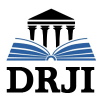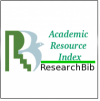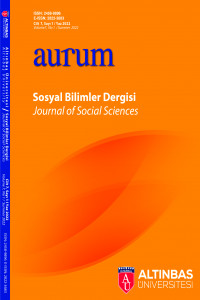Editorial
Research Article
Aim & Scope
AURUM Journal of Social Sciences (JSS) is an international, peer-reviewed social science journal published biannually in June and December, accepting manuscripts both in English and Turkish. AURUM JSS welcomes contributions in, but not limited to, the disciplines of international relations, political science and public administration, economy, business administration, law, sociology, psychology, and fine arts. The aim of the journal is to provide a forum for critical scholarship across the social sciences, for theoretical debates and empirical analyses that move away from narrow disciplinary focus. AURUM JSS strongly encourages interdisciplinary and comparative research.
AURUM JSS publishes original research articles, book reviews and review articles that reflect the diversity of the journal’s scope. The journal also invites guest editors for special issues. Each submission goes through a double-blind review process. AURUM JSS policy is that published articles make original and strong theoretical and/or empirical contributions in their scholarly fields.
AURUM Journal of Social Sciences is indexed in a number of national and international databases such as IdealOnline, Ulrich’s Periodicals Directory, Neliti, Directory of Research Journals Indexing (DRJI), ResearchBib (Academic Resource Index) and Index Copernicus, Asos Index, CiteFactor, ProQuest Central, ProQuest Turkey Database, Rootindex, International Institute of Organized Research (I2OR), Infobase index, Biblioteca IBT-CCG UNAM, Eurasian Scientific Journal Index (ESJI), SOBIAD.
Author Guidelines
AUTHOR GUIDELINES
(Author Guidelines for AURUM Journal of Social Sciences have been revised as of Summer 2021 Issue)
Word Limit
AURUM JSS accepts the following formats and limits:
• Research articles of 8-10,000 words (including abstract, notes and references) that adhere to our format, aims and scope.
• Book reviews of approximately 1,000 words.
• Review articles of 2,000-2,500 words.
Formatting the manuscript
Manuscripts should be submitted in Times New Roman size 12. The main text and footnotes should both be double-spaced and left-aligned. AURUM JSS uses both footnotes and a reference list. It is not the responsibility of the editors to convert your citation style. If you do not follow these guidelines you will be asked to reformat your paper prior to editing and this may cause publication delays.
Biographical statement
STYLE GUIDELINES
AURUM JSS uses APA formatting and style.
TITLES
Titles should be provided both in Turkish and English.
WORKS BY SINGLE AUTHOR:
Abstract (Abstract should be bold and capitalized.)
The texts should start with an abstract which is no longer than 200 words. The abstract should clearly summarise the main argument and the contribution of the article as well as the methodology utilised. The abstract should be written in the present tense and in the third person or passive voice; use of the first person is discouraged.
Abstracts should be provided both in English and Turkish.
KEYWORDS
Keywords: [provide up to 5 keywords separated with a comma. Capitalize each word.]
HEADINGS
There are 5 heading levels in APA. Regardless of the number of levels, always use the headings in order, beginning with level 1. The format of each level is illustrated below:
| APA Headings |
| Level | Format |
| 1 | Centered, Boldface, Title Case Heading Text starts a new paragraph. |
| 2 | Flush Left, Boldface, Title Case Heading Text starts a new paragraph. |
| 3 | Flush Left, Boldface Italic, Title Case Heading Text starts a new paragraph. |
| 4 | Indented, Boldface Title Case Heading Ending With a Period. Paragraph text continues on the same line as the same paragraph. |
| 5 | Indented, Boldface Italic, Title Case Heading Ending With a Period. Paragraph text continues on the same line as the same paragraph. |
IN-TEXT CITATION
A Work by One Author
Jones (2008) suggests that ….
(Jones, 2008)
A Work by Two Authors
Research by Wegener and Petty (1994) supports...
(Wegener & Petty, 1994)
A Work by Three or More Authors
(Kernis et al., 1993)
Kernis et al. (1993) suggest...
In et al., et should not be followed by a period. Only "al" should be followed by a period.
If you’re citing multiple works with similar groups of authors, and the shortened “et al” citation form of each source would be the same, you’ll need to avoid ambiguity by writing out more names. If you cited works with these authors:
Jones, Smith, Liu, Huang, and Kim (2020)
Jones, Smith, Ruiz, Wang, and Stanton (2020)
They would be cited in-text as follows to avoid ambiguity:
(Jones, Smith, Liu, et al., 2020)
(Jones, Smith, Ruiz, et al., 2020)
Since et al. is plural, it should always be a substitute for more than one name. In the case that et al. would stand in for just one author, write the author’s name instead.
Unknown Author
If the work does not have an author, cite the source by its title in the signal phrase or use the first word or two in the parentheses. Titles of books and reports are italicized; titles of articles, chapters, and web pages are in quotation marks. APA style calls for capitalizing important words in titles when they are written in the text (but not when they are written in reference lists).
A similar study was done of students learning to format research papers ("Using Citations," 2001).
Organization as an Author
According to the American Psychological Association (2000),...
First citation: (Mothers Against Drunk Driving [MADD], 2000)
Second citation: (MADD, 2000)
Two or More Works in the Same Parentheses
(Berndt, 2002; Harlow, 1983)
(Smith, n.d., 1995, 2002, in press)
REFERENCE LIST
BOOKS
Single Author
Last name first, followed by author initials.
Ahmed, S. (2012). On being included: Racism and diversity in institutional life. Duke University Press.
Two Authors
List by their last names and initials. Separate author names with a comma. Use the ampersand instead of "and."
Soto, C. J., & John, O. P. (2017). The next big five inventory (BFI-2): Developing and assessing a hierarchical model with 15 facets to enhance bandwidth, fidelity, and predictive power. Journal of Personality and Social Psychology, 113(1), 117-143. http://dx.doi.org/10.1037/pspp0000096
Three to Twenty Authors
List by last names and initials; commas separate author names, while the last author name is preceded again by ampersand.
Nguyen, T., Carnevale, J. J., Scholer, A. A., Miele, D. B., & Fujita, K. (2019). Metamotivational knowledge of the role of high-level and low-level construal in goal-relevant task performance. Journal of Personality and Social Psychology, 117(5), 879-899. http://dx.doi.org/10.1037/pspa0000166
More Than Twenty Authors
List by last names and initials; commas separate author names. After the first 19 authors’ names, use an ellipsis in place of the remaining author names. Then, end with the final author's name (do not place an ampersand before it). There should be no more than twenty names in the citation in total.
Pegion, K., Kirtman, B. P., Becker, E., Collins, D. C., LaJoie, E., Burgman, R., Bell, R., DelSole, R., Min, D., Zhu, Y., Li, W., Sinsky, E., Guan, H., Gottschalck, J., Metzger, E. J., Barton, N. P., Achuthavarier, D., Marshak, J., Koster, R., . . . Kim, H. (2019). The subseasonal experiment (SubX): A multimodel subseasonal prediction experiment. Bulletin of the American Meteorological Society, 100(10), 2043-2061. https://doi.org/10.1175/BAMS-D-18-0270.1
Group Author
Merriam-Webster. (2008). Braggadocio. In Merriam-Webster’s Advanced Learner’s English Dictionary. Merriam-Webster.
When a work has multiple layers of group authorship (e.g. The Office of the Historian, which is a part of the Department of State, publishes something), list the most specific agency as the author and the parent agency as the publisher.
Bureau of International Organization Affairs. (2018). U.S. contributions to international organizations, 2017 [Annual report]. U.S. Department of State. https://www.state.gov/u-s-contributions-to-international-organizations/
Unknown Author
When the work does not have an author move the title of the work to the beginning of the references and follow with the date of publication.
Merriam-Webster's collegiate dictionary (11th ed.). (2003). Merriam-Webster.
Two or More Works by the Same Author
Use the author's name for all entries and list the entries by the year (earliest comes first). List references with no dates before references with dates.
Urcuioli, P. J. (n.d.).
Urcuioli, P. J. (2011).
Urcuioli, P. J. (2015).
Edited Book with an Author or Authors
Author, A. A. (Year of publication). Title of work: Capital letter also for subtitle (E. Editor, Ed.). Publisher. DOI (if available)
Malory, T. (2017). Le morte darthur (P. J. C. Field, Ed.). D. S. Brewer. (Original work published 1469-70)
A Translation
Author, A. A. (Year of publication). Title of work: Capital letter also for subtitle (T. Translator, Trans.). Publisher. (Original work published YEAR) DOI (if available)
Plato (1989). Symposium (A. Nehamas & P. Woodruff, Trans.). Hackett Publishing Company. (Original work published ca. 385-378 BCE)
Edition Other Than the First
Author, A. A. (Year of publication). Title of work: Capital letter also for subtitle (# edition). Publisher. DOI (if available)
Belcher, W. (2019). Writing your journal article in twelve weeks: A guide to academic publishing success (2nd ed.). University of Chicago Press.
Article or Chapter in an Edited Book
Author, A. A., & Author, B. B. (Year of publication). Title of chapter. In E. E. Editor & F. F. Editor (Eds.), Title of work: Capital letter also for subtitle (pp. pages of chapter). Publisher. DOI (if available)
ARTICLES IN PERIODICALS
Article in Print Journal
Scruton, R. (1996). The eclipse of listening. The New Criterion, 15(3), 5–13.
Note: APA 7 advises writers to include a DOI (if available), even when using the print source. The example above assumes no DOI is available.
Article in Electronic Journal
As noted above, when citing an article in an electronic journal, include a DOI if one is associated with the article.
Baniya, S., & Weech, S. (2019). Data and experience design: Negotiating community-oriented digital research with service-learning. Purdue Journal of Service-Learning and International Engagement, 6(1), 11–16. https://doi.org/10.5703/1288284316979
Denny, H., Nordlof, J., & Salem, L. (2018). "Tell me exactly what it was that I was doing that was so bad": Understanding the needs and expectations of working-class students in writing centers. Writing Center Journal, 37(1), 67–98. https://www.jstor.org/stable/26537363
Article in a Magazine
Peterzell, J. (1990, April). Better late than never. Time, 135(17), 20–21.
Article in a Newspaper
Schultz, S. (2005, December). Calls made to strengthen state energy policies. The Country Today, 1A, 2A.
Review
Baumeister, R. F. (1993). Exposing the self-knowledge myth [Review of the book The self-knower: A hero under control, by R. A. Wicklund & M. Eckert]. Contemporary Psychology, 38(5), 466–467.
OTHER PRINT SOURCES
Entry in a Dictionary, Thesaurus, or Encyclopedia with a Group Author
Institution or organization name. (Year). Title of entry. In Title of reference work (edition, page numbers). Publisher name.
Merriam-Webster, Incorporated. (1997). Goat. In Merriam Webster’s collegiate dictionary (10th ed., pp. 499-500). Merriam-Webster, Incorporated.
Entry in a Dictionary, Thesaurus, or Encyclopedia with an Individual Author
Lastname, F. M. (Year). Title of entry. In F. M. Lastname (ed.), Title of reference work (edition, page numbers). Publisher.
Tatum, S. R. (2009). Spirituality and religion in hip hop literature and culture. In T. L. Stanley (ed.), Encyclopedia of hip hop literature (pp. 250-252). Greenwood.
Work Discussed in a Secondary Source
Provide the source in which the original work was referenced:
Nail, T. (2017). What is an assemblage? SubStance, 46(1), 21-37. http://sub.uwpress.org/lookup/doi/10.3368/ss.46.1.21
Dissertation or Master’s Thesis, Published
Lastname, F. M. (Year). Title of dissertation/thesis (Publication No.) [Doctoral dissertation/Master’s thesis, Name of Institution Awarding the Degree]. Database or Archive Name.
Angeli, E. L. (2012). Networks of communication in emergency medical services(Publication No. 3544643) [Doctoral dissertation, Purdue University]. ProQuest Dissertations Publishing.
Dissertation or Master’s Thesis, Unpublished
Lastname, F. M. (Year). Title of dissertation/thesis [Unpublished doctoral dissertation/master’s thesis]. Name of Institution Awarding the Degree.
Samson, J. M. (2016). Human trafficking and globalization [Unpublished doctoral dissertation]. Virginia Polytechnic Institute and State University.
Federal or State Statute
Name of Act, Public Law No. (Year). URL
The Patient Protection and Affordable Care Act, Publ. L. No. 111-148, 124 Stat. 119 (2010). https://www.govinfo.gov/content/pkg/PLAW-111publ148/pdf/PLAW-111publ148.pdf
Report by a Government Agency or Other Organization
Organization Name. (Year). Title of report. URL
United States Government Accountability Office. (2019). Performance and accountability report: Fiscal year 2019. https://www.gao.gov/assets/710/702715.pdf
Report by Individual Authors at Government Agency or Other Organization
Lastname, F. M., & Lastname, F. M. (Year). Title of report. Organization Name. URL
Palanker, D., Volk, J., Lucia, K., & Thomas, K. (2018). Mental health parity at risk: Deregulating the individual market and the impact on mental health coverage. National Alliance on Mental Illness. https://www.nami.org/About-NAMI/Publications-Reports/Public-Policy-Reports/Parity-at-Risk/ParityatRisk.pdf
Conference Proceedings
The 7th edition of the APA manual does not provide guidance on citing conference proceedings. Therefore, this citation models that of an edited collection, which is similar in format.
Lastname, F. M., & Lastname, F. M. (Eds.). (Year). Title of Proceedings. Publisher. URL (if applicable)
Huang, S., Pierce, R., & Stamey, J. (Eds.). (2006). Proceedings of the 24th annual ACM international conference on the design of communication. ACM Digital Library. https://dl.acm.org/citation.cfm?id=1166324&picked=prox
ELECTRONIC SOURCES
Webpage or Piece of Online Content
If the page names an individual author, cite their name first:
Lastname, F. M. (Year, Month Date). Title of page. Site name. URL
Price, D. (2018, March 23). Laziness does not exist. Medium. https://humanparts.medium.com/laziness-does-not-exist-3af27e312d01
Quotations and Citations
a. Formatting Quotations
For quoted material of less than three lines or ~40 words, AURUM JSS uses double quotes. Quotes within quotes are enclosed in single quotation marks. The footnote number comes after the closed quotation marks.
La Baronne Durand De Fontmagne, who lived in Istanbul during and after the Crimean War, writes that “Turks adore children and when they do not have their own, they willingly adopt an ‘enfant l’âme'.”33
For quoted material of more than three lines or ~40 words, format it as a block quote inset by a tab space without any quotation marks. Quotes within block quotes are enclosed in double quotation marks. The footnote number comes after the period in the final sentence.
b. Footnotes
Footnotes should be used only where substantive information is conveyed to the reader. Literature references should normally not necessitate separate notes (see the section on References). However, non-standard references (e.g. to press conferences, political statements, hearings, interviews, etc.) are best provided as notes.
Figures
a. Images: Digital files of images should be of the maximum size and resolution possible, with a minimum resolution of 200 dpi, and are to be provided as separate files. Authors are responsible for acquiring their own image permissions.
b. Graphs, Charts, Tables: Graphs, charts and tables are to be provided in a separate, editable document (either word processor or spreadsheet). Authors are responsible for acquiring permission to use datasets and for the accuracy of the data they use.
c. Placement and captions: The preferred location of all figures should be indicated in the main text. A full caption and any source citation / permission should be provided beneath the location of each figure.
TABLE 1 ABOUT HERE
Table 1. Students Sent to Paris from Istanbul Industrial School (1870–1872)
Source: Table is prepared based on the data provided by Şişman, Tanzimat Döneminde Fransa’ya Gönderilen Osmanlı Öğrencileri (1839–1876), 93–158.
FIG 1 ABOUT HERE
Figure 1. Maternity Ward (Viladethane) of Darülaceze.
Source: Unknown photographer, İstanbul Üniversitesi Kütüphane ve Dokümantasyon Daire Başkanlığı, Fotoğraf Albümler Dizini, 779-39-0023.
Ethical Principles and Publication Policy
AURUM Journal of Social Sciences
Editorial Policies and Ethical Guidelines
AURUM Journal of Social Sciences (JSS) adheres to rigorous publishing ethics involving authors, editors as well as reviewers. Its editorial policies and ethical guidelines aim to maintain the integrity of the whole publication process.
Peer Review Statement
All research articles in AURUM Journal of Social Sciences undergo rigorous peer review, based on initial editor screening and anonymized refereeing by two anonymous referees. All correspondence between the editorial office, authors and reviewers is considered private and confidential.
Ethical guidelines for journal editors
The editors of AURUM JSS are committed to adhere to the following policies and ethical guidelines:
• The editors of AURUM JSS give unbiased consideration to each manuscript submitted for publication. They judge each on its merits, without regard to race, religion, nationality, sex, seniority, or institutional affiliation of the author(s).
• They keep the peer-review process entirely confidential, and do not share information about a manuscript with anyone outside of the peer-review process.
• If a journal editor receives a credible allegation of misconduct by an author, reviewer, or journal editor, then s/he has a duty to investigate the matter further.
• The editors of AURUM JSS may reject a manuscript without formal peer review if it fails to comply with the ethical standards of the journal and outside its scope.
• They are responsible for processing submissions in due time.
• The editors need to decline considering any manuscript that may have conflict of interest with themselves. Such manuscripts will be re-assigned to another editor.
• If a journal editor receives convincing evidence that the main substance or conclusions of an article published in the journal are incorrect, then, in consultation with the editorial board, s/he ensures the publication of an appropriate note of correction.
Ethical guidelines for authors
AURUM JSS expects all authors to adhere to the following ethical standards:
• Each author is expected to have made substantial contributions to the conception or design of the work; or the acquisition, analysis, or interpretation of data; or have drafted the work or substantively revised it.
• Authors must avoid gift (guest) authorship where someone is added to the list of authors who has not been involved in writing the paper; and ghost authorship where someone has been involved in writing the paper but is not included in the list of authors.
• Prior to submission, the authorship list and order must be agreed between all authors, and they must also agree on who will take on the role of corresponding author. It is the responsibility of the corresponding author to reach consensus with all co-authors regarding all aspects of the article including the authorship order and to ensure all correct affiliations have been listed.
• Individuals who participated in the development of a manuscript but do not qualify as an author should be acknowledged. Organizations that provided support in terms of funding and/or other resources should also be acknowledged.
• Authors must ensure submitted manuscripts are the original works of the author(s). AURUM considers plagiarism a serious offense and is committed to eliminating manuscripts with possible cases of plagiarism from its review and publication process. The editors use plagiarism detection software to check each manuscript for possible cases of plagiarism.
Manuscripts that are found to contain unacceptable level of similarity with other published works are immediately rejected.
• Authors must avoid duplicate submissions. They must ensure the submitted manuscript is not under consideration by another journal. Duplicate submission also includes the submission of the same/similar manuscript in different languages to different journals.
• Authors should include only relevant citations. Inclusion of citations that are not relevant to the work is strongly discouraged. Similarly, irrelevant self-citation to increase one’s citation is unethical.
• Authors should disclose all financial/relevant interest that may have influenced the development of the manuscript.
• According to TR Index Criteria, The Statement on the Contribution of the Researchers; The Statement on Support and Acknowledgement, if there is any; and The Statement on Conflict should be indicated.
Ethical guidelines for reviewers
AURUM JSS expects all peer reviewers to follow the code of conduct and ethical guidelines below:
• Each submission in AURUM JSS goes through a double blind review process.
• Before accepting to review a manuscript, reviewers should ensure that the manuscript is within their area of expertise.
• Reviewers must give unbiased consideration to each manuscript submitted. They should judge each on its merits, without regard to race, religion, nationality, sex, seniority, or institutional affiliation of the author(s).
• They must declare any conflict of interest before agreeing to review a manuscript. This includes any relationship with the author that may bias their review.
• Reviewers must keep the peer review process confidential. They must not share information or correspondence about a manuscript with anyone outside of the peer review process.
• Reviewers need to provide a constructive, evidence based, and appropriately substantial peer review report.
• Reviewers must avoid making statements in their report which might be deemed as impugning any person’s reputation.
• Reviewers need to submit their report on time and should inform the editor if this is not possible.
• Reviewers should call to the journal editor’s attention any significant similarity between the manuscript under consideration and any published paper or submitted manuscripts of which they are aware.
• They must not use information obtained during the peer-review process for their own or any other person’s or organization’s advantage, or to disadvantage or discredit others.
Ethics approval
According to ULAKBİM TR Index Criteria, an ethics committee approval must be obtained for research conducted in all disciplines since 2020. The research which require an ethics committee approval are listed below:
• All kinds of research which are conducted with qualitative or quantitative approaches that require data collection from participants using questionnaires, interviews, focus group, observation, experimentation, interview techniques,
• Using humans and animals (including material / data) for experimental or other scientific purposes,
• Clinical research conducted on humans,
• Research conducted on animals,
• Retrospective studies in accordance with the law on the protection of personal data.
A report prepared for studies requiring ethic committee approval must include the name of the ethics committee and if it is available the reference number. If a study has been granted an exemption from requiring ethics approval, this should also be detailed in the manuscript (including the name of the ethics committee that granted the exemption). Manuscripts, which are detected that the research has not been carried out within an appropriate ethical framework, are not published in AURUM JSS. If your study does not require ethics committee approval, you must sign the declaration form indicating the relevant reasons for your manuscript.
Price Policy
Article submission, processing and publication for the AURUM Journal of Social Sciences is free of charge.
Indexes
Citation Indexes
Other Indexes
Journal Boards
Editors

Section Editors




Fırat Arapoğlu is an art historian, critic, and independent curator based in Istanbul, where he works as an associate professor in the Department of Common Courses at Altınbaş University. He has curated numerous exhibitions in Turkey and abroad. His recent projects include Intersections, Group Exhibition (2025, Vision Art Platform, İstanbul), Anita Taylor, Moonraker Solo Exhibition (2024, Vision Art Platform, Istanbul), A Journey A Slope, Ahmet Rüstem & Hakan Sorar Solo Exhibition (2024, Vision Art Platform, Istanbul), A Dream Unfolds, Aida Mahmudova solo exhibition (2024, Vision Art Platform, Istanbul), Fire, Albena Baeva solo exhibition (2024, Collect Gallery, Istanbul), In a Multiple Perspective, Group Exhibition (2022-2023, YARAT, Baku) Other Urban Orders, Sophia Grancharova solo exhibition (2022, the ICA, Sofia), Lines of Site, International Traveling Exhibition (2022, Istanbul, Dundee, Barcelona), 6. International Istanbul Children and Youth Biennial (2022, Istanbul), “Unforgettable Future,” Krassimir Terziev solo exhibition (2019, Versus Art Projects, Istanbul) can be mentioned. He has co-curated the 3rd Çanakkale Biennial, the 3rd and 4th International Mardin Biennials, and the 1st Mediterranean Contemporary Art Biennial. Among the art magazines he has contributed to in Turkey and abroad are Sanat Dünyamız, Genç Sanat, Art-İst Modern & Actual, ICE, ARTAM, Art Unlimited, Eleştirel Kültür, RH+, İstanbul Art News, Artdog İstanbul, Varlık, and Flash Art. He has written articles on art and art education, presented papers at national and international symposia, and authored book chapters. He has given lectures and workshops at the Istanbul Modern Art Museum, Moda Sahnesi, Atölye Maçka, Narmanlı Art, Nazım Hikmet Cultural Center, and Istanbul Bilgi University. He is a member of the International Association of Art Critics.





Associate Editors

Language Editors

Turgut Turunc has been involved in teaching English and teacher training for more than 25 years.
After his graduation from Foreign Languages Academy of Gazi University Education Faculty - Ankara-Turkey, he completed his BA in teaching English as a foreign language at Anadolu University - Eskisehir-Turkey. He obtained his MSc degree in Teaching English as a Foreign Language (MSc in TESOL) at Aston University, Birmingham, U.K.
He is currently affiliated with the School of Foreign Languages (SFL) at Altinbas University (AU), – Istanbul-Turkey, working as a teacher trainer. He is involved in observing the instructors in their actual teaching setting to provide them with constructive feedback functioning as the continuing professional development unit (CPDU) in addition to Quality Assurance and Accreditation works at the AU-SFL.
Before his current position at AU; he worked for Oxford University Press – Turkey (OUP-TR) functioning as a teacher trainer and the higher education coordinator for five years for the second time, for the first of which he worked as an educational consultant for the same company for another five years.
At the MA Programme in TEFL at Bahçeşehir University (BAU) – Istanbul, Turkey, he delivered courses titled: Approaches & Methods in ELT, TEFL Theory into Practice, Course & Materials Design, Language Testing, and ICT in ELT. He was also the teacher trainer for BAU English preparatory program, where he delivered teacher training seminars and workshops. He was also involved in observing the instructors in their actual teaching setting providing them with constructive feedback aligned with his responsibilities in the professional development unit (PDU) within a developmental teacher observation program (DOP).
Before BAU, he functioned as the director of education and a teacher trainer responsible for foreign language studies at Bahçeşehir - Uğur Educational Institutions, which include a chain of more than 250 K-12 schools located in different cities of Turkey.
While he worked as an English teacher and as head of English department at different public schools in Turkey, he ran teacher training seminars and workshops for EFL teachers around the country, organized by the In-service teacher training department of Turkish Ministry of National Education (MoNE).
His research interests include teaching methodology, professional development, curriculum & materials development and ICT in ELT.


Editorial Board
Assoc. Prof. Dr. Cansu Yildirim received her Bachelor’s Degree from the Faculty of Economics and Administrative Sciences, Izmir University of Economics in 2009. After getting her MSc Degree in Operations, Project, and Supply Chain Management from University of Manchester (2010), she took a scholarship from Izmir University of Economics, and received her PhD Degree in 2015, with a Marketing major. In 2016, she was assigned as an Assistant Professor in the Department of Maritime Business Administration at Dokuz Eylul University. She has publications in Journal of Consumer Behaviour, Journal of Brand Management, Production Planning & Control, and Journal of Service Theory and Practice.


Dr. Abdullah Açık received his Bachelor’s degree in Maritime Business Administration from Dokuz Eylül University, Maritime Faculty in 2013.
He continued his postgraduate studies in the same department, earning his Master’s degree in 2016 and completing his Ph.D. in 2020.
In 2021, he was awarded the title of Associate Professor in the field of International Trade.
His primary research interests include the freight market, dry bulk and tanker shipping, maritime economics, and econometrics.
Advisory Board
Danışma Kurulu / Advisory Board
Uğurcan AKYÜZ, Toros Üniversitesi
Ali ALP, TOBB Ekonomi ve Teknoloji Üniversitesi
Ayşegül ALTINBAŞ, Altınbaş Üniversitesi
Barrie AXFORD, Oxford BrookesUniversity
Ali DAYIOĞLU, Yakın Doğu Üniversitesi
Ahmet DIRISS, Centre des Etudes Méditerranéennes et Internationales- Tunis
Devrim ERBİL, Mimar Sinan Güzel Sanatlar Üniversitesi
François GEORGEON, EHESS
Boris JELEV, St.Cyril and St. Mathodius University
Ahmet Kasım HAN, İstanbul Aydın Üniversitesi
Cemal KAFADAR, Harvard University
Hasan KÖNİ, Kültür Üniversitesi
Heinz-Peter MARCEL, Köln University
Antje NÖTZOLD, Chemnitz University
Kaan H. ÖKTEN, Mimar Sinan Güzel Sanatlar Üniversitesi
Çınar ÖZEN, Ankara Üniversitesi
Alessandro QUARENGHI, Milan Catholic University
Şükran ŞIPKA, Altınbaş Üniversitesi
Alexandre TOURMAKINE, Institut National des Langues et Civilisations Orientales (Inalco), Fransa
Zehra YILMAZ, Van Yüzüncü Yıl Üniversitesi

Prof.Dr. Uğurcan Akyüz -özet özgeçmiş-
1961 yılında Artvin, Hopa'da doğdum, ilk ve orta öğrenimini orada tamamladım. 1983 yılında Gazi Üniversitesi, Eğitim Fakültesi Resim Bölümünden mezun oldum. Bir süre yarı zamanlı grafik tasarımcısı olarak TÜBİTAK için çalıştım. 1985 yılında Hacettepe Üniversitesi (HÜ) Güzel Sanatlar Fakültesi'nde öğretim görevlisi oldum. Yüksek Lisansımı; HÜ Güzel Sanatlar Fakültesi Grafik Bölümü'nde “Görüntünün Fotografik Analizi: Portre” başlıklı tezim ile 17.06.1987’de tamamladım.
1989 yılında "Sabaha Karşı Bir Zaman" adlı kitabım yayımlandı. HÜ GSF’de sürdürmekte olduğum Sanatta Yeterlik çalışmasının tez aşamasında iken kazandığım YÖK bursu ile 1990 yılında İngiltere’ye gittim. Leicester De Montfort University (DMU), School of Design and Manufacture’da doktora çalışmasına başladım. 1994 yılında JF Laxton bursu ile ödüllendirildim ve aynı yıl DMU’de yarı zamanlı öğretim görevlisi olarak çalıştım. DMU'den; “To create a Model for 2-Dimentional Marks” başlıklı tezim ile 16.01.1995 tarihinde doktora (Ph.D) derecesi alarak Türkiye’ye döndüm. 31.03-30.11.1995 tarihleri arası 1.Ordu Komutanlığında askerlik görevimi tamamladım.
17.11.1997 yılında Doçent unvanını aldım; 9.04.2003'te profesör oldum, HÜ Grafik Bölümü başkanlığına atandım. 2004 yılında Goethe Enstitüsünden aldığım araştırma bursu ile Münih'e gittim, HÜ Güzel Sanatlar Enstitüsü Müdürlüğüne atandım.
2006 yılında, (KKTC) Yakın Doğu Üniversitesi, Güzel Sanatlar ve Tasarım Fakültesi'nin kuruluşunu gerçekleştirdim ve 28.12.2009’a kadar dekanlığını yaptım. 29 Aralık 2009'da HÜ Güzel Sanatlar Fakültesi'ne dekan olarak atandım. 2010 yılında fakülte SANAT KURUMU ve ÇAĞSAV kurumsal ödüllerini aldı.
HU GSF'de dekanlığım döneminde; altı sempozyum kitabı, yirmi sergi kataloğu, altı hakemli dergi, üç retrospektif kitabı, üç mezuniyet sergi kataloğu ve fakültenin üç broşürü yayınlandı. Hacettepe Sanat Müzesi Müdürlüğü sırasında ise müze, sanatçı bağışları ile ikiyüzün üzerinde eser kazandı.
1996’da Ankara’da, 2007’de ise KKTC’de açılan ilk dijital resim sergileri dahil; onbiri yurtdışında, toplam yirmiiki kişisel sergi açtım. Sergilerim ile ilgili sekiz katalog ve çeşitli makaleler yayınlandı. Altı uluslararası kongreye baş konuşmacı olarak davet edildim. Sanat, grafik tasarım, yeni medya, görsel sanatlar, sanat eğitimi ve fotografik konularında seminerler verdim. Yurtiçi ve yurt dışında çeşitli yarışmalı ve karma sergilere, bienallere katıldım, çalıştaylarda yer aldım. Pek çok akademik iş birliği ile sanatsal etkinliğin oluşumvea rol aldım ve gerçekleştirdim:
2005’de HÜ Sanat Müzesi Kurumsal Kimlik, Tanıtım Kampanyası ve Sanat Kataloğu Tasarımı projesi; Stuttgart, Hochschule der Medien ile HÜ arasında “Bilgisayar Grafiği ve Grafik Canlandırma Bilim Uzmanlığı Programı” oluşturulması, 2009’da YDÜ ile KKTC İçişleri Bakanlığı Merkezi Cezaevi’ne “Seramik Atölyesi Kurulması” projelerini gerçekleştirdim. Aynı yıl YDÜ, HÜ ve Aksaray Üniversiteleri ortak “Yaz Akademisini” organize ettim. “AKADEMİADA Uluslararası Sanat Akademisi”ni kurdum ve yedi yıl etkinlik düzenledim. 2010, 2012 ve 2014 Asya Sanat Bienalinde Türkiye’yi temsil ettim ve katılımcı seçimini yaptım. Çin-Qingdao Technical College ile HÜ arasında iş birliği, Kore-National University of Arts ile HÜ arasında iş birliği protokol ve projeleri, 2011 ve 2012’de gerçekleştirilen HÜ.GSF, uluslararası MACSABAL sempozyumları ile 2012’de HÜ.GSF “Yeni Dünya Düzeninde Sanat” sempozyumunu gerçekleştirdim.
Uygulanmış heykel projelerim: 2023 “Balıkçı Teknesi”, 2022 “Sardalya” Karaduvar, Mersin. 2017 Proje danışmanı: “İrfan Günsel anıt mezarı”, Lefkoşa. 2016 “Ercan Havaalanı Rauf Denktaş anıtı”, Lefkoşa. 2016 “Aphrodite anıt heykeli”, Lefkoşa. 2015 “Mouflon anıt heykel projesi”, Lefkoşa.
2016’da YDÜ’de Avrasya VI-Uluslararası Mimari, İnşaat mühendisliği ve Tasarım okulları festivaline dekan olarak ev sahipliği yaptım.
Ayrıca; 2014’de KKTC YDÜ’de, 2019’da Almanya, Stadtallendorf kentinde ve 2023’de ise Toros Üniversitesinde ilk Uluslararası Sanat Çalıştaylarını gerçekleştirdim. Altısı yurtdışında toplam yirmibir çalıştaya katıldım.
Kültür Bakanlığının düzenlediği 65.Devlet Resim ve Heykel Yarışmasında Türk sanatı tarihinde ilk defa bir dijital çalışmaya verilen “başarı” ödülü de dahil on iki ödül aldım. 2016’da Kazakistan Pavlodar State Üniversitesi "Bilge Adam" ödülüne layık görüldüm. Yerel ve uluslararası müzelerde, koleksiyonlarda çok sayıda eserim bulunmaktadır. Eylül 2018'de Bosna Hersek Tarih Müzesine dört eserim birden kabul edilmiştir.
2020’de “Yazdan Geriye Kalan” adlı güftem bestelenmiştir, videosu: https://www.youtube.com/watch?v=AXY8uYabtTU
2014 yılında 16. Asya Sanat Bienaline jüri üyesi olarak seçildim.
Farklı sanat ve tasarım dergilerinde hakemlik, yarışmalarda ve sınavlarda jüri üyeliği yaptım. Bu arada; 15 profesör, 20 doçent ve 37 yardımcı doçentin akademik dosyasına rapor yazdım.
2010-12 yılları arasında Üniversitelerarası Kurul Sanat Alanı Dekanlar konseyi ve Eğitim Komisyonu; 2012-15 yılları arasında Üniversitelerarası Kurul Doçentlik Üst Komisyonu, 2014-17 yılları arasında KKTC MEKB Kültür Sanat Danışma Kurulu üyelikleri yaptım.
17 Ekim 2012 tarihinde HÜ Güzel Sanatlar Fakültesi dekanlık görevimden istifa ettikten sonra, 22 Ekim 2012'de YDÜ Güzel Sanatlar ve Tasarım Fakültesinde (dekan) tekrar çalışmaya başladım. 19 Şubat 2014- 01 Mart 2017 tarihleri arası YDÜ Mimarlık Fakültesi dekanı olarak görevlendirildim.
YDÜ Sanat ve Tasarım Araştırmaları Merkezinin 2013’de kurulmasını; YDÜ Sanat ve Tasarım (2013), Mimarlık (2014) ve İç Mimarlık (2014) doktora programlarının açılmalarını ve onaylanmalarını YÖDAK ve YÖK nezdinde sağladım.
Sekiz sanatta yeterlik, onbir doktora ve yirmibir yüksek lisans öğrencisine danışmanlık yaptım. Ayrıca onbeş gazete makalem, elliiki sunu yazım, indeksli dergilerde yedi makalem ve yirmiüç bildirim yayınlandı. Kıbrıs Postası ve ardından Kıbrıs Gazetelerinde, “Yakından Sanat” adlı kendi sayfamda haftalık olarak kesintisiz yüzotuzbeş makale yazdım. Bununla beraber; Yakın Doğu TV için hazırlayıp sveuğum Yakından Sanat adlı TV programı seksenbeş hafta BRT-2’de yayınlandı.
01 Mart 2018'de YDÜ'den istifa ettim, 18 Mart 2018-01 Nisan 2021 tarihleri arası kadromu İstanbul Ayvansaray Üniversitesinde idi.
2019 yılında "Kendime Dersler-bir dekanın yazıları-" adlı kitabım yayımlandı. Yayın aşamasında biri şiir, iki kitabım daha bulunmaktadır.
2018-2022 yılları arasında akademik ve sanatsal faaliyetlerimi Frankfurt’ta sürdürdüm.
25.4.2022’den beri Toros Üniversitesinde; 11.4.2023 tarihinden beri de Güzel Sanatlar, Tasarım ve Mimarlık Fakültesi dekanı olarak görev yapmaktayım.
Advisory Board
Prof. Han is the Vice-Rector of İstanbul's Beykoz University and Deputy Chairman of the Board of Trustees of TED University in Ankara. He has held high-level academic and administrative roles as Vice Rector, Dean, and advisor to the Rector and the Board of Trustees at Aydın, Altınbaş, and Kadir Has Universities, as well as serving as Department Chair. Previously, he directed the Research Center for Political Science and International Relations at Istanbul University and served as a faculty member in the Faculty of Economics at Istanbul University. Prior to that he was also a faculty member in the MBA programs at Istanbul Bilgi University. Actively involved in civil society organizations, Prof. Han is Vice President and Chair of the Academic Research at the Turkish Democracy Foundation and a board member at the Center for Economics and Foreign Policy Studies (EDAM), one of Turkey’s leading independent think tanks. Additionally, Prof. Dr. Ahmet Kasım Han is the academic coordinator of the Political Leadership Excellence Program, a joint initiative of Konrad Adenauer Stiftung and EDAM, providing strategic guidance and training to aspiring young leaders.
In the field of defense and strategic studies, Prof. Han served as an Adjunct Professor of Strategy at the Atatürk Institute for Strategic Studies of the Turkish National Defense University until 2020 and was an academic advisor at the Armed Forces Joint Operations Higher Command and Control Academy of the Staff College. He currently works as a Senior Research Fellow on the Middle East and North Africa at the Italian Institute for International Political Studies (ISPI) in Milan. He has contributed to the “On Turkey” series by the German Marshall Fund of the United States and participated in high-level diplomatic initiatives addressing various international crises and issues related to energy resources, conflict resolution, and peacebuilding in the Middle East, Eastern Europe, and the Asia-Pacific regions. Furthermore, he has served and continues to serve on the advisory, review, and academic boards of several academic journals, like International Relations, the first Turkish journal indexed in the SSCI, published by the International Relations Council of Turkey, and Defence Against Terrorism Review published by the NATO Centre of Excellence for Defence Against Terrorism (COE-DAT) amongst others.
Prof. Han completed his undergraduate, graduate, doctoral, and post-doctoral studies in economics, international relations, strategy, finance, and negotiation strategies at Istanbul, Boğaziçi, Koç, and Harvard Universities. He has also been a visiting lecturer at the Center for Syrian Studies at the University of St. Andrews and at the Moshe Dayan Center at Tel Aviv University. In 2003, he was recognized as one of the "Fifteen Young Leaders of Europe" by the U.S. Department of State and was awarded a scholarship for their prestigious foreign policy studies program. In 2015, he was awarded another scholarship by Tel Aviv University for studies on Israel and the Middle East. In 2024, he participated in the Strategic Planning for Political Parties program under the Friedrich Naumann Foundation’s International Academy for Leadership.

Prof.Dr. Uğurcan Akyüz -özet özgeçmiş-
1961 yılında Artvin, Hopa'da doğdum, ilk ve orta öğrenimini orada tamamladım. 1983 yılında Gazi Üniversitesi, Eğitim Fakültesi Resim Bölümünden mezun oldum. Bir süre yarı zamanlı grafik tasarımcısı olarak TÜBİTAK için çalıştım. 1985 yılında Hacettepe Üniversitesi (HÜ) Güzel Sanatlar Fakültesi'nde öğretim görevlisi oldum. Yüksek Lisansımı; HÜ Güzel Sanatlar Fakültesi Grafik Bölümü'nde “Görüntünün Fotografik Analizi: Portre” başlıklı tezim ile 17.06.1987’de tamamladım.
1989 yılında "Sabaha Karşı Bir Zaman" adlı kitabım yayımlandı. HÜ GSF’de sürdürmekte olduğum Sanatta Yeterlik çalışmasının tez aşamasında iken kazandığım YÖK bursu ile 1990 yılında İngiltere’ye gittim. Leicester De Montfort University (DMU), School of Design and Manufacture’da doktora çalışmasına başladım. 1994 yılında JF Laxton bursu ile ödüllendirildim ve aynı yıl DMU’de yarı zamanlı öğretim görevlisi olarak çalıştım. DMU'den; “To create a Model for 2-Dimentional Marks” başlıklı tezim ile 16.01.1995 tarihinde doktora (Ph.D) derecesi alarak Türkiye’ye döndüm. 31.03-30.11.1995 tarihleri arası 1.Ordu Komutanlığında askerlik görevimi tamamladım.
17.11.1997 yılında Doçent unvanını aldım; 9.04.2003'te profesör oldum, HÜ Grafik Bölümü başkanlığına atandım. 2004 yılında Goethe Enstitüsünden aldığım araştırma bursu ile Münih'e gittim, HÜ Güzel Sanatlar Enstitüsü Müdürlüğüne atandım.
2006 yılında, (KKTC) Yakın Doğu Üniversitesi, Güzel Sanatlar ve Tasarım Fakültesi'nin kuruluşunu gerçekleştirdim ve 28.12.2009’a kadar dekanlığını yaptım. 29 Aralık 2009'da HÜ Güzel Sanatlar Fakültesi'ne dekan olarak atandım. 2010 yılında fakülte SANAT KURUMU ve ÇAĞSAV kurumsal ödüllerini aldı.
HU GSF'de dekanlığım döneminde; altı sempozyum kitabı, yirmi sergi kataloğu, altı hakemli dergi, üç retrospektif kitabı, üç mezuniyet sergi kataloğu ve fakültenin üç broşürü yayınlandı. Hacettepe Sanat Müzesi Müdürlüğü sırasında ise müze, sanatçı bağışları ile ikiyüzün üzerinde eser kazandı.
1996’da Ankara’da, 2007’de ise KKTC’de açılan ilk dijital resim sergileri dahil; onbiri yurtdışında, toplam yirmiiki kişisel sergi açtım. Sergilerim ile ilgili sekiz katalog ve çeşitli makaleler yayınlandı. Altı uluslararası kongreye baş konuşmacı olarak davet edildim. Sanat, grafik tasarım, yeni medya, görsel sanatlar, sanat eğitimi ve fotografik konularında seminerler verdim. Yurtiçi ve yurt dışında çeşitli yarışmalı ve karma sergilere, bienallere katıldım, çalıştaylarda yer aldım. Pek çok akademik iş birliği ile sanatsal etkinliğin oluşumvea rol aldım ve gerçekleştirdim:
2005’de HÜ Sanat Müzesi Kurumsal Kimlik, Tanıtım Kampanyası ve Sanat Kataloğu Tasarımı projesi; Stuttgart, Hochschule der Medien ile HÜ arasında “Bilgisayar Grafiği ve Grafik Canlandırma Bilim Uzmanlığı Programı” oluşturulması, 2009’da YDÜ ile KKTC İçişleri Bakanlığı Merkezi Cezaevi’ne “Seramik Atölyesi Kurulması” projelerini gerçekleştirdim. Aynı yıl YDÜ, HÜ ve Aksaray Üniversiteleri ortak “Yaz Akademisini” organize ettim. “AKADEMİADA Uluslararası Sanat Akademisi”ni kurdum ve yedi yıl etkinlik düzenledim. 2010, 2012 ve 2014 Asya Sanat Bienalinde Türkiye’yi temsil ettim ve katılımcı seçimini yaptım. Çin-Qingdao Technical College ile HÜ arasında iş birliği, Kore-National University of Arts ile HÜ arasında iş birliği protokol ve projeleri, 2011 ve 2012’de gerçekleştirilen HÜ.GSF, uluslararası MACSABAL sempozyumları ile 2012’de HÜ.GSF “Yeni Dünya Düzeninde Sanat” sempozyumunu gerçekleştirdim.
Uygulanmış heykel projelerim: 2023 “Balıkçı Teknesi”, 2022 “Sardalya” Karaduvar, Mersin. 2017 Proje danışmanı: “İrfan Günsel anıt mezarı”, Lefkoşa. 2016 “Ercan Havaalanı Rauf Denktaş anıtı”, Lefkoşa. 2016 “Aphrodite anıt heykeli”, Lefkoşa. 2015 “Mouflon anıt heykel projesi”, Lefkoşa.
2016’da YDÜ’de Avrasya VI-Uluslararası Mimari, İnşaat mühendisliği ve Tasarım okulları festivaline dekan olarak ev sahipliği yaptım.
Ayrıca; 2014’de KKTC YDÜ’de, 2019’da Almanya, Stadtallendorf kentinde ve 2023’de ise Toros Üniversitesinde ilk Uluslararası Sanat Çalıştaylarını gerçekleştirdim. Altısı yurtdışında toplam yirmibir çalıştaya katıldım.
Kültür Bakanlığının düzenlediği 65.Devlet Resim ve Heykel Yarışmasında Türk sanatı tarihinde ilk defa bir dijital çalışmaya verilen “başarı” ödülü de dahil on iki ödül aldım. 2016’da Kazakistan Pavlodar State Üniversitesi "Bilge Adam" ödülüne layık görüldüm. Yerel ve uluslararası müzelerde, koleksiyonlarda çok sayıda eserim bulunmaktadır. Eylül 2018'de Bosna Hersek Tarih Müzesine dört eserim birden kabul edilmiştir.
2020’de “Yazdan Geriye Kalan” adlı güftem bestelenmiştir, videosu: https://www.youtube.com/watch?v=AXY8uYabtTU
2014 yılında 16. Asya Sanat Bienaline jüri üyesi olarak seçildim.
Farklı sanat ve tasarım dergilerinde hakemlik, yarışmalarda ve sınavlarda jüri üyeliği yaptım. Bu arada; 15 profesör, 20 doçent ve 37 yardımcı doçentin akademik dosyasına rapor yazdım.
2010-12 yılları arasında Üniversitelerarası Kurul Sanat Alanı Dekanlar konseyi ve Eğitim Komisyonu; 2012-15 yılları arasında Üniversitelerarası Kurul Doçentlik Üst Komisyonu, 2014-17 yılları arasında KKTC MEKB Kültür Sanat Danışma Kurulu üyelikleri yaptım.
17 Ekim 2012 tarihinde HÜ Güzel Sanatlar Fakültesi dekanlık görevimden istifa ettikten sonra, 22 Ekim 2012'de YDÜ Güzel Sanatlar ve Tasarım Fakültesinde (dekan) tekrar çalışmaya başladım. 19 Şubat 2014- 01 Mart 2017 tarihleri arası YDÜ Mimarlık Fakültesi dekanı olarak görevlendirildim.
YDÜ Sanat ve Tasarım Araştırmaları Merkezinin 2013’de kurulmasını; YDÜ Sanat ve Tasarım (2013), Mimarlık (2014) ve İç Mimarlık (2014) doktora programlarının açılmalarını ve onaylanmalarını YÖDAK ve YÖK nezdinde sağladım.
Sekiz sanatta yeterlik, onbir doktora ve yirmibir yüksek lisans öğrencisine danışmanlık yaptım. Ayrıca onbeş gazete makalem, elliiki sunu yazım, indeksli dergilerde yedi makalem ve yirmiüç bildirim yayınlandı. Kıbrıs Postası ve ardından Kıbrıs Gazetelerinde, “Yakından Sanat” adlı kendi sayfamda haftalık olarak kesintisiz yüzotuzbeş makale yazdım. Bununla beraber; Yakın Doğu TV için hazırlayıp sveuğum Yakından Sanat adlı TV programı seksenbeş hafta BRT-2’de yayınlandı.
01 Mart 2018'de YDÜ'den istifa ettim, 18 Mart 2018-01 Nisan 2021 tarihleri arası kadromu İstanbul Ayvansaray Üniversitesinde idi.
2019 yılında "Kendime Dersler-bir dekanın yazıları-" adlı kitabım yayımlandı. Yayın aşamasında biri şiir, iki kitabım daha bulunmaktadır.
2018-2022 yılları arasında akademik ve sanatsal faaliyetlerimi Frankfurt’ta sürdürdüm.
25.4.2022’den beri Toros Üniversitesinde; 11.4.2023 tarihinden beri de Güzel Sanatlar, Tasarım ve Mimarlık Fakültesi dekanı olarak görev yapmaktayım.
Editorial Board
Yayın Kurulu / Editorial Board
Abdullah AÇIK, Dokuz Eylül Üniversitesi
Ahmet Serhat ERKMEN, Altınbaş Üniversitesi
Alper KALİBER, Altınbaş Üniversitesi
Atilla ÇİFTER, Altınbaş Üniversitesi
Ayla ESEN, Bahçeşehir Üniversitesi
Aylin İLDEN KOÇKAR, İstanbul Bilgi Üniversitesi
Aytül Ayşe CENGİZ, Anadolu Üniversitesi
Berna AKÇINAR, Işık Üniversitesi
Berna KARAÇALI, İstanbul Topkapı Üniversitesi
Cansu YILDIRIM, Dokuz Eylül Üniversitesi
Didem DANIŞ, Galatasaray Üniversitesi
Diğdem SOYALTIN COLELLA, Aberdeen Üniversitesi
Emre ESEN, İstanbul Üniversitesi
Erol ÜLKER, Işık Üniversitesi
Fatoş ALTINBAŞ, Altınbaş Üniversitesi
Hasan SINAR, Altınbaş Üniversitesi
Janet BARIŞ, Altınbaş Üniversitesi
Muhittin SAĞNAK, İzmir Katip Çelebi Üniversitesi
Nihan AKDEMİR, İstanbul Topkapı Üniversitesi

Dr. Abdullah Açık received his Bachelor’s degree in Maritime Business Administration from Dokuz Eylül University, Maritime Faculty in 2013.
He continued his postgraduate studies in the same department, earning his Master’s degree in 2016 and completing his Ph.D. in 2020.
In 2021, he was awarded the title of Associate Professor in the field of International Trade.
His primary research interests include the freight market, dry bulk and tanker shipping, maritime economics, and econometrics.

Assoc. Prof. Dr. Cansu Yildirim received her Bachelor’s Degree from the Faculty of Economics and Administrative Sciences, Izmir University of Economics in 2009. After getting her MSc Degree in Operations, Project, and Supply Chain Management from University of Manchester (2010), she took a scholarship from Izmir University of Economics, and received her PhD Degree in 2015, with a Marketing major. In 2016, she was assigned as an Assistant Professor in the Department of Maritime Business Administration at Dokuz Eylul University. She has publications in Journal of Consumer Behaviour, Journal of Brand Management, Production Planning & Control, and Journal of Service Theory and Practice.


































